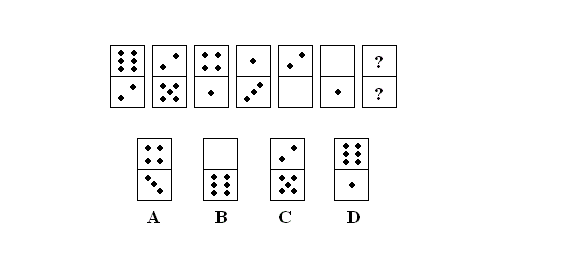
GRADEMPIRE
RECRUITMENT ADVICE & SERVICES
There are two main types of abstract and logic tests.
1) Diagramatic: Shown above.
Diagrammatic reasoning tests present questions in the form of diagrams where a number of logical rules apply. Your task is to identify the underlying patterns and rules and use these to select the missing shape from the options provided.
The key to Diagrammatic reasoning tests is logical thinking, and although the level of difficulty and complexity of the diagrammatic reasoning test will vary based on the specific job requirements, it is based on the same ability type. For example, a candidate applying for a job with the police department would take a less complex diagrammatic reasoning test than a candidate applying for a job as a marketing manager.
2) Logical:
Similar to deductive reasoning tests and verbal reasoning tests, logical reasoning aptitude tests are designed to measure your ability to draw logical conclusions based on statements or arguments, and to identify the strengths and weaknesses of those arguments.
Logical reasoning aptitude test example questions:
Question example 1:
Only fish oil contains Omega 3.Only foods that contain Omega 3 help with brain development.
Which conclusion can be derived from the combination of these two statements?
-
All fish oils help with brain development.
-
Only what contains Omega 3 is fish oil.
-
All that helps with brain development is fish oil.
-
There are fish oils that help with brain development.
Answer explanation:
Option 3 is the correct answer. From the first statement, we can conclude: fish oil => contains Omega 3. The second statement tells us: that which contains Omega 3 => helps with brain development. If we combine the two statements in reverse, we can see: helps with brain development => contains Omega 3 => fish oil. Thus, helps with brain development => fish oil.
Question example 2:
To every question there is an answer.
From this statement, which of the following is not possible?
-
There is an answer that does not address any question.
-
If there is a question, then it has an answer.
-
Sam answered me, though I didn’t ask a question.
-
The professor discussed questions that have no answer.
Answer explanation:
Option 4 is the correct answer. If “every question has an answer”, then the statement “the professor discussed questions that have no answer” cannot be true. Therefore, answer D is not possible.
Abstract and Logic
A logical reasoning test is often termed abstract reasoning test or logical aptitude test. In any case a combination of inductive and deductive reasoning is required to solve the test questions.
 Q1Correct Answer is A: There is an increase in the number of squares after each step. Colours change after each step. |  Q2Correct answer is d. The shape rotates clockwise each step. At each step, the shape loses a section of its antenna (LHS antenna on the first image) |  Q3Correct Answer is d. In the first column, there is 0 then 1 then 2 squares in each row. (Increase by one each time). Same applies to the second column which has 1, 2, 3 squares. According to this logic, the unknown box has 4 squares. Hence the answer is a or d. Then look at the rows. In each row, the squares in the same corner have the same colour (black) and each new square added is white. So the answer is d. |
|---|---|---|
 Q4The correct answer is B Starting from the top of the first image and then going down diagonally and then diagonally up and so on, the numbers are 6,5,4,3,2,1. So the next image should have zero on the top. |